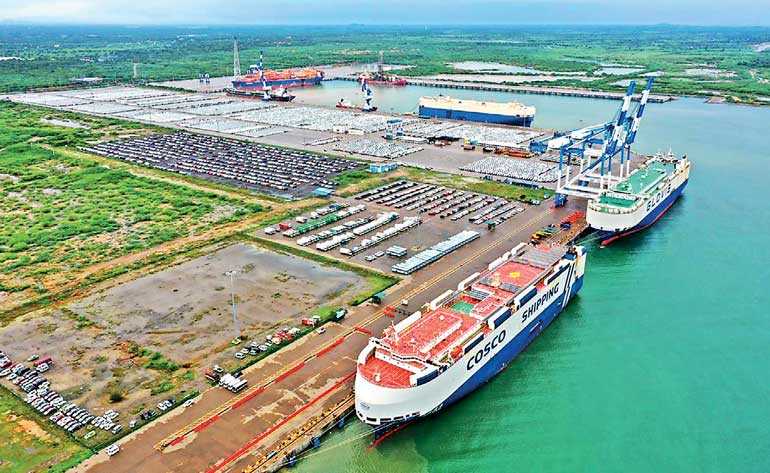Thursday Jul 04, 2024
Thursday Jul 04, 2024
Tuesday, 2 June 2020 00:00 - - {{hitsCtrl.values.hits}}

Sri Lanka’s Hambantota Port has become a focal point for debate about the BRI. When the country could not pay back its debt, the China asserted ownership over the port and other important assets. American officials often cite this case to support the claim that China is engaged in “debt-trap diplomacy”
Washington, D.C.: When the pandemic subsides, the economic devastation will preoccupy governments worldwide for months to come. China will present itself as a partner for the economic recovery. China’s approach to economic recovery globally may come with waste, fraud and political manipulation. These risks have not dissuaded potential partners previously, who hoped to tap into the more than ten-fold expansion of the Chinese economy over the past three decades.
The tide may be turning. Washington D.C.-based Foundation for Defense of Democracies (FDD) has just released ‘Below the Belt and Road: Corruption and Illicit Dealings in China’s Global Infrastructure,’ an in-depth analysis of China’s Belt and Road Initiative (BRI), its flagship program for external investment. The report’s author, Elaine Dezenski, suggests that “Beijing’s partners may become saddled with expensive but under-utilised infrastructure, massive debt, and political instability.”
Dezenski serves on FDD’s Board of Advisors of the Center on Economic and Financial Power and is a senior advisor to K2 Financial Integrity Network.
One of the cases studies in the report focuses on Chinese investments in Sri Lanka. Sri Lanka’s Hambantota Port has become a focal point for debate about the BRI. When the country could not pay back its debt, the China asserted ownership over the port and other important assets. American officials often cite this case to support the claim that China is engaged in “debt-trap diplomacy.”
A rigorous review of the evidence, however, suggests that Port Hambantota is less an example of debt-trap diplomacy or an intentional seizure of key assets. Rather, it is an example of corruption and cronyism backfiring on both the Chinese and their local partners.
The project, which feasibility studies questioned from the beginning, required more than $1 billion in loans from China – loans that theoretically would be repaid from port proceeds. After the port was built, no one came. Unable to make payments on the debt, Sri Lankan authorities agreed to surrender the lease on the port and surrender land to a Chinese company, in exchange for a release from financial obligations.
“More than an example of debt entrapment, the Sri Lankan port fiasco is a story of the dangers of corruption,” according to the FDD report’s author. Chinese officials used the project to funnel millions of dollars to former President Rajapaksa’s 2015 election coffers, Dezenski explains.
Dezenski also writes that the Sri Lankan case raises crucial questions about the economic viability of BRI projects and the ultimate purpose of BRI funds as well. “Is China loaning massive amounts of money to build infrastructure or to buy allegiance, or perhaps both,” she asks. What happens when loans cannot be repaid? Is Sri Lanka “an outlier or a harbinger?”
The 29-page report also outlines US policy recommendations that “provide BRI recipients with an alternative to dependence on Beijing.”
First, it recommends promoting a “global dialogue and foreign investment strategy that pushes anti-corruption and transparency to the top of the agenda.” In addition to demonstrating a sustainable, safer model of bilateral investment, the US should “continue its outspoken support for multilateral anti-corruption and governance conventions of development institutions such as the World Bank, United Nations, and OECD.”
Second, the US and its allies should “double down” on its support for “anti-corruption standards and norms across global businesses, banks, governmental institutions, and supporting organisations.” This includes strengthening “new equity investments … that attracts partners, reduces governance risks, and offers viable alternatives to countries that seek a better way of building public infrastructure.” Third, the report recommends increasing “pressure on China to prosecute the foreign corrupt practices of its State Own Enterprises, private firms, and nationals.” It highlights that China’s “little inclination to pursue Chinese-driven corruption that occurs abroad” merits action.
Lastly, the report recommends supporting “BRI recipient countries in the impartial adjudication of corruption disputes, including stolen asset recovery,” especially since “developing countries are often unable to prosecute grand corruption cases arising from BRI projects” and therefore, often “have no choice but to turn to the contractually mandated system of Chinese arbitration, which are unlikely to address either grand corruption or asset recovery.”
Dezenski concludes that “renewed trust is the real dividend of these efforts, as global citizens reap the benefits of high-quality infrastructure.”